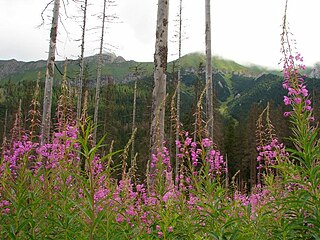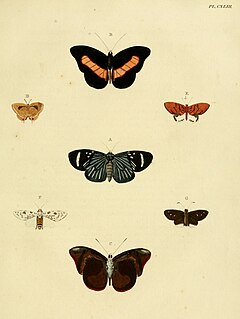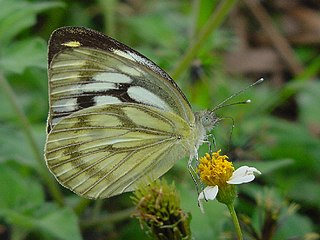
A woodland or wood is a low-density forest forming open habitats with plenty of sunlight and limited shade. Woodlands may support an understory of shrubs and herbaceous plants including grasses. Woodland may form a transition to shrubland under drier conditions or during early stages of primary or secondary succession. Higher density areas of trees with a largely closed canopy that provides extensive and nearly continuous shade are referred to as forests.

A biogeographic realm or ecozone is the broadest biogeographic division of the Earth's land surface, based on distributional patterns of terrestrial organisms. They are subdivided into ecoregions, which are classified based on their biomes or habitat types.

The Palearctic or Palaearctic is one of the eight biogeographic realms on the Earth's surface, first identified in the 19th century, and is still in use as the basis for zoogeographic classification. The Palearctic is the largest of the eight realms. It stretches across all of Europe, Asia north of the foothills of the Himalayas, North Africa, and the northern and central parts of the Arabian Peninsula.
A bioregion is an ecologically and geographically defined area that is smaller than an ecozone, but larger than an ecoregion or an ecosystem, in the World Wildlife Fund classification scheme. There is also an attempt to use the term in a rank-less generalist sense, similar to the terms "biogeographic area" or "biogeographic unit".

The Lecithoceridae, or long-horned moths, are a family of small moths described by Simon Le Marchand in 1947. Although lecithocerids are found throughout the world, the great majority are found in the Indomalaya ecozone and the southern part of the Palaearctic ecozone.

The Western Palaearctic or Western Palearctic is part of the Palaearctic ecozone, one of the eight ecozones dividing the Earth's surface. Because of its size, the Palaearctic is often divided for convenience into two, with Europe, North Africa, northern and central parts of the Arabian Peninsula, and part of temperate Asia, roughly to the Ural Mountains forming the western zone, and the rest of temperate Asia becoming the Eastern Palaearctic. Its exact boundaries differ depending on the authority in question, but the Handbook of the Birds of Europe, the Middle East, and North Africa: The Birds of the Western Palearctic) (BWP) definition is widely used, and is followed by the most popular Western Palearctic checklist, that of the Association of European Rarities Committees (AERC). The Western Palearctic ecozone includes mostly boreal and temperate climate ecoregions.

The Cochylini are a tribe of tortrix moths. It used to be classified as the subfamily Cochylinae.

Amblypodia is a genus of butterflies in the family Lycaenidae. Several species formerly placed here are now in Arhopala and Flos, although this placement is not necessarily definite.

Anthene is a genus of butterflies in the family Lycaenidae, commonly called the ciliate blues or hairtails. The genus was erected by Edward Doubleday in 1847.

Artipe is a genus of butterflies in the family Lycaenidae. The species of this genus are found in the Indomalaya ecozone, the Palearctic ecozone and the Australasian ecozone.

Matsutaroa is a butterfly genus in the family Lycaenidae. It is nearest to the genus Ancema, but differs from it in the following points: (1) veins 5 and 6 on the forewing are not very close at their origins, but in Ancema they are very close at their origins; (2) the ground colour of the underside of the male is white, tinged with pale yellow and blue and has no shade of silver, but in the genus Ancema the ground colour of the underside is more or less tinged with silver; (3) in the male genitalia the valva is stout, a short brachial process is separating from the dorsum of the valva, and the phallus is stout, but in Ancema the valva is slender, a long brachial process separating from the ventral direction of valva, and the phallus is very slender.
The Montane Cordillera Ecozone, as defined by the Commission for Environmental Cooperation (CEC), is an ecozone in south-central British Columbia and southwestern Alberta, Canada. A rugged and mountainous ecozone spanning 473,000 square kilometres, it still contains "two of the few significant agricultural areas of the province", the Creston Valley and the Okanagan Valley. Primarily a mountainous region, it consists of rugged ecosystems such as alpine tundra, dry sagebrush and dense conifer forests. The interior plains are encircled by a ring of mountains. The area has a mild climate throughout the year, with typically dry summers and wet winters.
The Taiga Plain Ecozone, as defined by the Commission for Environmental Cooperation (CEC), is a Canadian terrestrial ecozone that covers most of the western Northwest Territories, extending to northwest Alberta, northeast British Columbia and slightly overlapping northeastern Yukon.
The Boreal Cordillera Ecozone, as defined by the Commission for Environmental Cooperation (CEC), is a Canadian terrestrial ecozone occupying most of the northern third of British Columbia and southern half of the Yukon. Within it is found Kluane National Park and Reserve, and a small portion of the southern range of Nahanni National Park Reserve. Most of the area's population is based in the city of Whitehorse, and it contains most of the Yukon's population. The portion in British Columbia is barely populated.

Ancema ctesia, the bi-spot royal, is a species of blue butterfly (Lycaenidae) found in Pakistan and India.

Spalgis is a genus of butterflies in the family Lycaenidae. Spalgis are found in the Australasian ecozone, the Indomalaya ecozone and the Afrotropic ecozone. The genus was erected by Frederic Moore in 1879.

Upolampes is a monotypic genus of butterfly in the family Lycaenidae. Its single species, Upolampes evena, is found in New Guinea, from Western New Guinea to Papua New Guinea and Karkar Island.

Cepora is a genus of butterflies, commonly called gulls, in the family Pieridae. The genus contains about 20 species shared between the Indomalayan ecozone and the Australasian ecozone.
Heinemannia is a genus of moths of the family Elachistidae.













